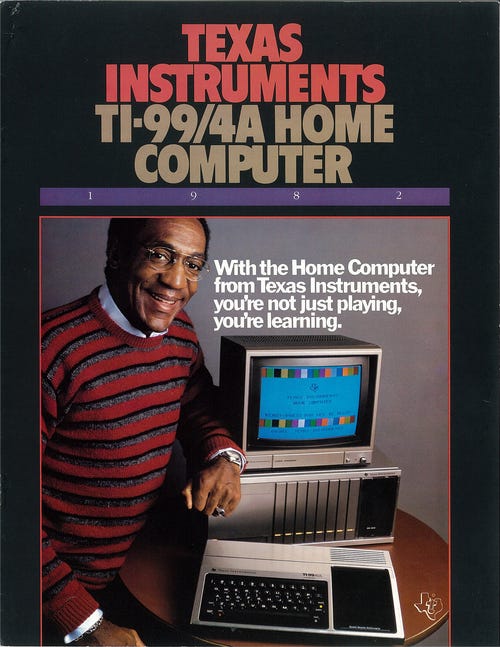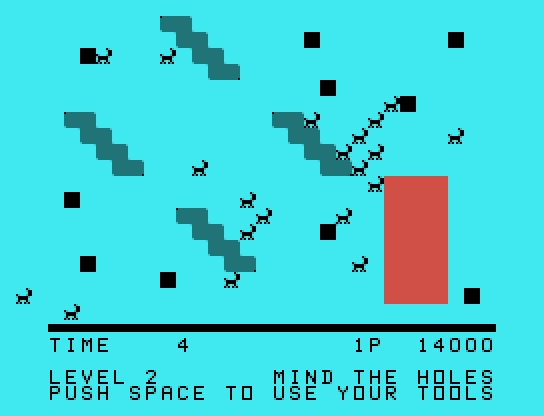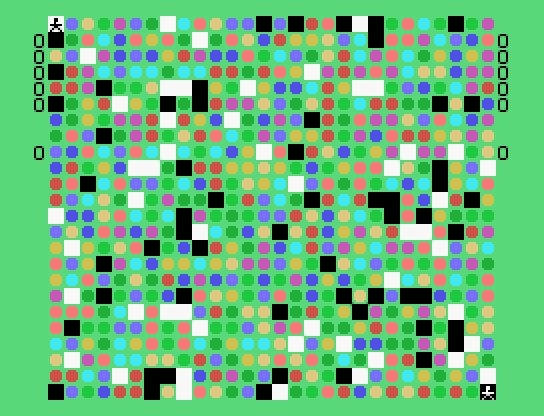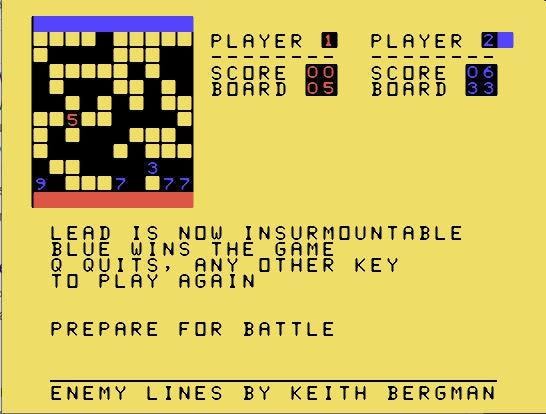The Goat That Crashed the Line
One more project, bro, just one more
One of the reasons I’m so fixated on to-do lists and catching up long-dormant projects is the protracted origin story behind my life as a retro hobbyist, and how it functions as a microcosm for the frustrations I feel trying to accomplish other things in life. I don’t know if other people view their own past like I do, or if they ever let go of ideas they had and didn’t see through, but sometimes I feel like I’m dragging chains forty years in the making behind me.
I never meant to be a curator on the trailing edge of technology, but my first computer was a TI 99/4A bought from a surplus catalog a few years after it was discontinued. When I joined the party, in 1987 or 1988, there was still talk of a next-generation TI-compatible machine, and a user base kept hopeful by occasional game-changing software and hardware releases, plus announcements of a whole lotta shit that never came out.
If you think your sports team has spent a lifetime breaking your heart, you’ve barely scratched the surface of what it means to be a 99’er.

I threw in the towel in the early 90s, selling off my 99/4A gear in a moment of financial peril, and then bailing on the Commodore Amiga to join the masses and get my first Windows PC. And for a few years there, I had one computer that was just a tool, like an answering machine or a microwave. It had no personality, even with its cow-spotted Packard Bell box, but it wasn’t a thing I needed to attend meetings or subscribe to a newsletter to keep up on. It was a nice change of pace, to be honest.
But almost as soon as I found myself married with kids in a house, and no longer apartment-hopping, I picked up another TI 99/4A rig. When we moved into our current place in 2009, with its finished basement, the idea of the War Room became a goal. It’s proceeded in fits and starts, and will probably never be complete to my satisfaction, but I now have a dozen or so computers at their own dedicated workstations, each with dedicated power outlets and shelving, and I can fire them up whenever I want.
I still have a 5 ¼” TI disk labeled “MANIFEST DESTINY WORK DISK” that I know was formatted and used as far back as 2005. I remember setting aside weekends in the earliest days of our time in this house to “finish this game once and for all” before entering a poorly-rendered, half-completed game called Herding Cats into a programming contest. (Manifest Destiny’s ideas have long since been cannibalized into other games).

The oldest thing currently still on the workbench is Enemy Lines, a board game I started in 2011. I wrote myself into a corner with it, while realizing it’s actually a really fun game (if you’re into Risk or Stratego). My son and I played it a bunch, I think during some snow days off school, and he actually enjoyed it, which is more than could be said for most of the retro stuff I showed him over the years. The 2-player version works, the AI almost does, but the code is so old and poorly-organized, I may wind up needing to rewrite it from scratch.
Somewhere in there I released Crystal Garden, a sliding tile game I compiled from BASIC to assembly language to speed it up, and which is interesting if barely playable. The first “modern era” game I started, finished, and would consider a legitimate piece of my “body of work” is Dicecrash (think “Tetris meets Yahtzee”) in 2015. It too could stand a rewrite, but as you may be gathering, that’s not exactly a high priority here at HQ.
Putting out Rabbits and Robots a couple weeks ago was the first thing I’ve finished and released in two years. It was a big deal for me, because it’s the first “harvest” of the most sustained coding time I’ve invested in years. I’m trying to work on games daily, go back through my archives, and get all these half-finished concepts off my hard drive and out into the world. There are at least a dozen right now, some nearly complete, others barely sketched-out concepts or bug-ridden clunkers in need of a top-down redesign.
And that’s just games in BASIC, or one of its dialects, on the 99/4A. I have grand, nebulous plans to convert my games to run on an Apple II or a Commodore 64. I’d like to learn other programming languages. I’m still plugging away at trying to archive my collection and catalog all these old forgotten disks and tapes.
And all that, my friends, is why when I get a new idea, like I did last week, part of me starts crying like the mother Elvis sings about on “In the Ghetto.” We do not need another mouth to feed, or a brand new project on the board. The ideas hurt the ideas. We need to prune the (crystal) garden. Some of this shit’s gotta go, man.

But then I grab the graph paper, and I draw a goat, and I define four characters like animation cels, and I make it do a flip on the screen with a cute little noise. And I start picturing a playfield, and several AI actors creating chaos. And I think to myself “I could bang this idea out in a week! Probably less! This is a 48-hour game jam if ever there was one!”
I could fill a file folder with notes from other games that coulda been 48-hour game jams, and are now collecting cobwebs on the ponderous yearly to-do list while I draw backflipping goats.
But maybe it’s where I am in life, and maybe it’s passing 50, but there’s a real sense of “if not now, when?” happening for me this year. I’ve never kept up a routine of daily walks like this. My finances are more organized than they’ve ever been in my life. I can get from one end of my garage to the other without climbing atop milk crates. And I’ve been coding every day, here at my relatively clean desk, staying in the zone so I can keep momentum going.
So fuck it. Goats and Golems is partly done, and it’s cute, and I’m gonna finish it. And then I’ll get back to Tollkeeper, and Harridan Bay, and Enemy Lines, and Ruinsweeper, and Break-In, and Knight Invaders… these are all mine, by the way, so don’t go stealing my great ideas!
Or, you know what, maybe do. Even at this newfound pace, it might be two years before I even notice.



